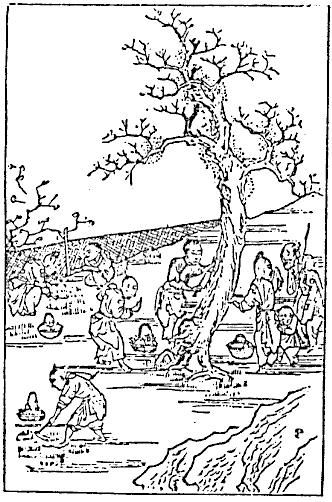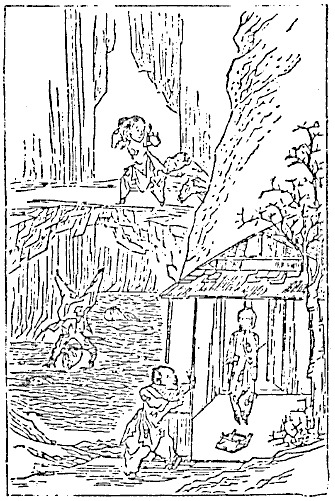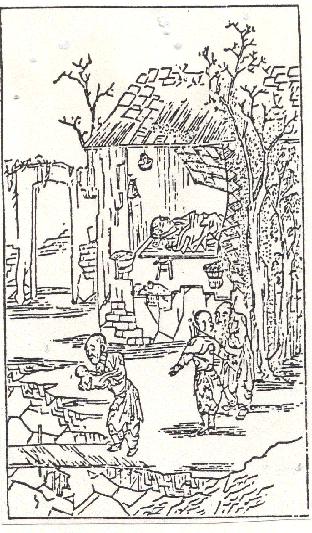Qing China's Internal Crisis:
Land Shortage,
Famine, Rural Poverty |
 |
|
|
Introduction
Even without the foreign onslaught, nineteenth century China faced enormous
problems, many of them resulting from an escalating population. By the
mid-nineteenth century China's population reached 450 million or more,
more than three times the level in 1500. The inevitable results were
land shortages, famine, and an increasingly impoverished rural population.
Heavy taxes, inflation, and greedy local officials further worsened the
farmer's situation. Meanwhile, the government neglected public works
and the military, and as bureaucratic efficiency declined, landowners,
secret societies, and military strongmen took over local affairs. Rebellion,
lawlessness, and foreign exploitation continued to plague the Qing regime
until the Revolution of 1911 ended China's imperial tradition. The following
readings give a sense of the host of domestic issues facing the Chinese
state, and also point to the evolution of a completely different way
of thinking about and handling China's problems. |
|
Crisis in Population and Ecology Unfortunately
for China, the demands of western powers and the devastation caused by
rebellions coincided with other social crises which challenged the Chinese
government and people. Foremost among these crises was a tremendous population
increase which put an enormous strain on already hard-pressed resources.
During the long period of peace from the late 17th century until the
end of the 18th century, the population of China more than doubled, growing
from nearly 150 million to over 300 million. The next period, 1779-1850,
brought another 56% increase, bringing the total population to 430 million
(approximately 1/2 the 1980 total) on the eve of the great Taiping rebellion
of mid-century. This population spurt was all the more difficult to deal
with since by the late 18th century there were few regions left which
could absorb more internal migration. Even frontier areas like the west
and south-west were filling up. As in other times of Chinese history,
there were creative responses: more intense irrigation, the development
of earlier ripening strains of rice that allowed double cropping, and,
most importantly, the gradual acceptance of New World food crops such
as maize (corn), sweet potatoes, tobacco and peanuts for marginal lands.
But these agricultural advances were double-edged: they may have resulted
in more food, animal feed, and fuel, but they also led to erosion of
the more intensely cultivated hills and the beginnings of a labor surplus,
particularly in crowded areas like the lower Yangtze delta.
But it was not only food production and available opportunities for
work that could not keep up with the population surge. The machinery
of government had been reasonably well-suited for a smaller population,
yet a proportionate increase in administrative personnel was not made
to keep pace with the population. By the 19th century, it is estimated
that a direct magistrate, the lowest level official responsible for all
local administration, might be responsible for as many as 250,000 people.
Small wonder that when real crises came, officials in government were
powerless to avoid them, and people had nothing to fall back on except
for some meager donations and national and international relief efforts,
which reached few people. To get an idea of the extent of the suffering
in the late nineteenth century look closely at the woodblock prints from
the China Famine Relief Fund distributed in Europe. As you view them,
keep in mind that they were produced during one of the most disastrous
famines in recent Chinese history, which took place between 1876-1879.
It affected all five provinces of north China and claimed at least 9.5
million lives. The immediate cause was a three year drought which withered
crops from 1873-6.
| back to top | |
|
Woodblock Prints: Images of Famine
 |
They Sell Their Fields and Take
Their Houses to Pieces (to Sell the Materials)
For a time the sufferers could borrow from one another, but this
came to an end. Then they killed their ploughing oxen and pawned
their implements of agriculture, their coverlets and clothes; and
at last they gave up all thoughts of the future, and fell to selling
their furniture and the materials of their houses, and many of their
fields, for a mere song, till at last no purchaser could be found.
Think of this, ye who live in high halls and fine houses, and let
your hearts move. |
 |
They Strip
Off the Bark of Trees and
Dig Up the Grass Roots for Food
The glowing sun is in the sky and the locusts cover the ground.
There is no green grass in the fields and no smoke of cooking from
the houses. They caught rats, or spread their nets for birds, or
ground the wheat-stalks into powder, or kneaded the dry grass into
cakes. Alas! What food was this for men! They were at last reduced
to the straits seen in the picture.
Ye who spend large sums every day on your food, will you not give
these sufferers a cup of soup? |
 |
Suicides in Consequence of the Famine
The old and weak find it hard to trudge along. The young and solitary
and feeble are not accustomed to run about. They wait for death in
their houses, stripped of everything. The cold winds pierce through
their bones. They have no rice to cook, and the cravings of hunger
are most painful. There is no way by which they can ascend to heaven,
no door by which they can enter the earth. All their plans are exhausted.
To die is better for them than to live. They hang themselves from
beams, or throw themselves into the rivers. Everywhere such heartrending
sights are to be seen. |
 |
A Famishing Woman Is Taken
in Labor,
Mother and Child Both Die
What can be the result of such an event amidst
the horrors of the famine? A birth in the open air under ordinary
circumstances is perilous; but here, in a strange place, with disease
and death around, the famishing mother gasps her last, and the child
gives a few feeble wails and dies. Very few babes are born to live
in this year of famine; where are the kind people to supply the swaddling
clothes and money necessary to keep them alive? |
| Text and illustrations from The
Famine in China, Committee of the China Famine Relief Fund
(London: C. Kegan Paul and Co., 1878). |
| back to top | |
|
Primary Source:
"Starvation" This following
excerpt is from a Chinese woman's account of the period ten years
after the 1876-1879 famine, when another great famine afflicted North
China. When she was older, this woman, Ning Lao Tai Tai, narrated
the story of her harsh life. At the time of this story, she is a
young woman with two children, married to a man who has turned out
to be an opium addict. (By the late 19th century, it is estimated
that in some areas of China, as much as 80% of the population of
villages were frequent users of opium, and the average is estimated
at perhaps 10% of the entire population.) This selection gives us
a glimpse into what life was like for Ning Lao Tai Tai in North China
in 1887-88.
Day after day I sat at home. Hunger gnawed. What could I do? My
mother was dead. My brother had gone away. When my husband brought
home food I ate it and my children ate with me. A woman could not
go out of the court. If a woman went out to work the neighbors
all laughed. They said, "So and so's wife has gone out to service." Or
they said, "So and so's daughter has gone out to service." I
did not know enough even to beg. So I sat at home and starved.
I was so hungry one day that I took a brick, pounded it to bits,
and ate it. It made me feel better.
How could I know what to do? We women knew nothing but to comb our
hair and bind our feet and wait at home for our men. When my mother
had been hungry she had sat at home and waited for my father to bring
her food, so when I was hungry I waited at home for my husband to
bring me food.
My husband sold everything we had.
There was a fur hat. He wanted to sell it. But I begged him not
to sell it.
"Let's keep this." It was my uncle's. "Take my
coat." He
took the coat and sold it for grain. When he came home for food
he drank only two bowls of millet gruel. I wondered why he ate
so little. I looked and found that the hat was gone, and knew that
he had sold it for opium. Those who take opium care not for food.
...
One year after my mother died I got a stick and a bowl and started
out begging. It was the spring of the year and I was twenty-two.
It was no light thing for a woman to go out of her home. That is
why I put up with my old opium sot so long. But now I could not
live in my house and had to come out. When I begged I begged in
the parts of the city where I was not known, for I was ashamed.
I went with my begging stick (the little stick with which beggars
beat off dogs) up my sleeve, that people should not see it. Every
day we went out begging. My husband carried the baby and led Mantze.
When we came to an open gate I would send her in, for people's
hearts are moved by a child. ...
Reprinted with permission from Ida Pruitt, A Daughter
of Han: The Autobiography of a Chinese Working Woman (Stanford:
Stanford University Press, 1967), 55, 62.
| back to top | |
|
| Discussion
Questions and Suggested Exercises
Questions
- How and why did demographic and ecological problems make matters
worse for the Chinese government in the late 19th century?
- Why is it that women are often more severely afflicted during times
of hardship than men?
- Why was begging so difficult for Ning Lao Tai Tai? What were the
alternatives for her and her children?
- Since the late 19th century there have been cycles of opium use and
suppression. The period pre-1906 was one of extensive use, 1906-15
of almost total suppression, 1915-45 of use again, and 1945 to the
present of suppression. Some analysts conclude that the period of suppression
matched times of strong government and others believe it was due to
the people's spirit of nationalism and national pride. How can either
of these explanations be related to opium use? What implications does
this have for our society today?
Activity 1: Analyzing Famine
Experts usually regard famine as largely a man-made
catastrophe, as opposed to natural disasters like hurricanes or tornadoes,
although the effects of the latter are certainly made worse by short-sighted
construction and energy products. Measures to prevent famine, therefore,
must take into account the different factors in any catastrophe and assign
a degree of responsibility. Look at the list below and rank each factor
from 1-5 which you think are responsible for the human and financial
costs of the Great North China Famine. Next, detail what measures would
specifically target that factor.
____ nature
____ government infrastructure (roads, communication)
____ local government
____ individuals
____ western powers
Activity 2: Famine Relief
Write to a relief agency (international organizations such as Oxfam,
Red Cross, American Friends Service, Doctors Without Borders, and the
United Nations) for information, or have a representative from the
agency come to speak to the class about the organization's work and
the needed resources — human, financial, and material — to implement
relief projects.
Follow up this activity by raising the questions, such as: Does the
relief work implemented by such agencies address or ameliorate the
root causes of disasters such as famine? What sort of measures would
address the underlying causes of crises? What would have addressed
the causes of disasters in nineteenth century China?
| back to top | |
|
|



